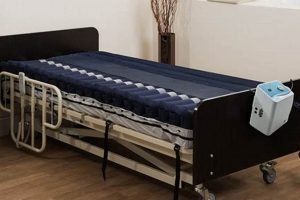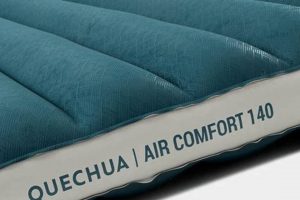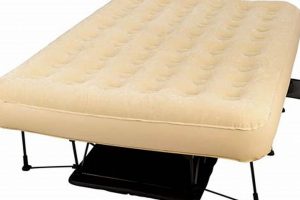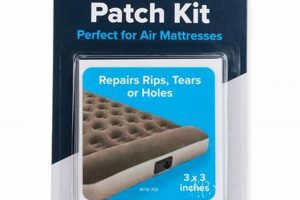Addressing breaches in inflatable sleeping surfaces is a common maintenance concern. These surfaces, designed for temporary bedding solutions, are susceptible to punctures and tears. Repairing these perforations is essential to maintain the intended air retention and functionality of the product. A small aperture, for instance, can rapidly deflate the entire structure, rendering it unusable for its intended purpose.
The ability to restore the integrity of an inflatable mattress offers both economic and practical advantages. It extends the lifespan of the item, preventing premature disposal and the need for replacement. Furthermore, it ensures that the mattress remains a viable option for guests, camping trips, or temporary sleeping arrangements, providing a comfortable and reliable surface when needed. Historically, techniques for mending such flaws have ranged from makeshift solutions to commercially available repair kits.
The following discussion will delve into effective strategies and materials for resolving these instances, offering practical guidance on identifying the location of the problem and executing a durable and lasting resolution. Different methodologies will be examined, catering to various types and sizes of inflatable mattresses and the specific nature of the defect.
Repairing Inflatable Mattress Perforations
Effective repair of inflatable mattresses necessitates meticulous preparation and the application of proven techniques. The following guidelines offer strategies to ensure a durable and lasting restoration.
Tip 1: Precise Location Identification: Immerse the inflated mattress section by section in water, or apply a soapy solution to the surface. Observe for the formation of bubbles, which indicate the point of egress.
Tip 2: Surface Preparation is Critical: Clean the area surrounding the aperture with isopropyl alcohol to remove any dirt, grease, or residue. This ensures optimal adhesion of the patching material.
Tip 3: Employ Appropriately Sized Patches: The patch should extend at least one inch beyond the perimeter of the defect. This distribution of pressure minimizes the risk of future failures.
Tip 4: Adhesive Application Protocol: Apply a thin, even layer of adhesive to both the patch and the prepared surface of the mattress. Allow the adhesive to become tacky before bonding the surfaces together.
Tip 5: Secure Bonding Technique: Once the adhesive is tacky, firmly press the patch onto the mattress, ensuring a complete seal. Use a smooth, hard object (e.g., a roller or the back of a spoon) to apply consistent pressure across the entire patch surface.
Tip 6: Extended Curing Time is Necessary: Allow the adhesive to cure for a minimum of 24 hours before reinflating the mattress. This allows the bond to fully develop its strength.
Tip 7: Reinforcement for Larger Defects: For tears exceeding one inch in length, consider using a fabric backing in addition to the patch. This provides structural support and prevents the tear from propagating.
Tip 8: Consider Internal Patching: For hard-to-reach areas, an internal patch can be applied. This involves carefully inserting the patch through the hole, applying adhesive, and securing it to the inner surface of the mattress using a long, thin tool.
Adhering to these tips will significantly enhance the probability of a successful and long-lasting repair, extending the service life of the inflatable mattress and mitigating the need for replacement.
The subsequent sections will address the selection of appropriate repair materials and explore alternative repair strategies for different types of inflatable mattress damage.
1. Identification
Accurate identification of the perforation’s location represents the initial and arguably most critical phase in the restoration of an inflatable mattress. A failure to pinpoint the precise point of air egress renders subsequent repair efforts ineffective and wasteful. The relationship is causal: the successful address of the “air mattress fix hole” is directly dependent on the accurate identification of said hole. Examples range from submersion in water, the careful observation of bubble formation at the site of the breach, to the application of soapy water solutions. In each instance, the principle remains the same: locate the point where air escapes to facilitate targeted intervention. Without this definitive localization, the repair becomes akin to searching for a needle in a haystack.
The practical significance of meticulous identification extends beyond the immediate repair. It informs the selection of appropriate repair materials and techniques. A small puncture, for example, might only require a small patch, while a larger tear necessitates a reinforced solution. Furthermore, the location of the perforation can influence the repair approach. Holes near seams often demand specialized techniques to ensure a lasting seal. Ignoring this initial step often results in repeated failures and ultimately, the premature disposal of the mattress.
In summary, the connection between identification and a successful “air mattress fix hole” repair is undeniable. It is the foundational element upon which all subsequent actions are predicated. Challenges associated with identification, such as locating small leaks in complex mattresses, underscore the importance of employing systematic and thorough methods. This understanding is central to the broader goal of effective maintenance and prolonged use of inflatable sleeping surfaces.
2. Preparation
In the context of an “air mattress fix hole” scenario, preparation encompasses the necessary preliminary steps undertaken to ensure a successful and lasting repair. The absence of proper preparation directly correlates with a higher probability of repair failure, necessitating repeated attempts or rendering the mattress irreparable. This phase involves cleaning the area surrounding the aperture, deflating the mattress to facilitate manipulation, and gathering the requisite tools and materials. For instance, failing to remove dirt or oils from the mattress surface before applying a patch compromises the adhesive bond, leading to premature detachment and subsequent air leakage. Similarly, neglecting to deflate the mattress makes the application of a patch uneven and prone to stress points.
The practical application of thorough preparation extends beyond the immediate task of patching the hole. It contributes to the overall longevity of the repair and the extended lifespan of the mattress. A well-prepared surface ensures optimal adhesion, minimizing the risk of future leaks originating from the same area. Furthermore, proper preparation enables a more precise application of the patching material, reducing the likelihood of creating new stress points or weak areas adjacent to the original defect. Consider the scenario of a camping trip where a
hastily applied patch fails due to inadequate cleaning, resulting in an uncomfortable and sleepless night. This underscores the importance of methodical preparation as a critical component of a reliable repair.
In summary, preparation is not merely a preliminary step but an integral component of a successful “air mattress fix hole” endeavor. Challenges, such as accessing hard-to-reach areas or dealing with stubborn contaminants, highlight the need for adaptability and resourcefulness in this phase. Overlooking this crucial aspect undermines the entire repair process, leading to suboptimal results and potential wastage. The direct link between meticulous preparation and the durability of the repair emphasizes its fundamental importance in maintaining the utility and extending the lifespan of inflatable mattresses.
3. Material Selection
The selection of appropriate materials directly influences the success and longevity of any attempt to remediate a breach in an inflatable mattress. This consideration extends beyond mere patching and encompasses adhesives, reinforcing agents, and cleaning solutions. Inappropriate material selection inevitably leads to premature repair failure, underscoring the critical importance of a deliberate and informed approach.
- Patch Material Compatibility
The patch material must be chemically compatible with the mattress material. Most inflatable mattresses are constructed from polyvinyl chloride (PVC) or thermoplastic polyurethane (TPU). Employing a patch made of an incompatible material, such as a rubber patch on a PVC mattress, will result in poor adhesion and eventual detachment. The patch material must also possess sufficient flexibility and tensile strength to withstand repeated inflation and deflation cycles without tearing or losing its bond. A common example involves using a vinyl repair kit specifically designed for vinyl air mattresses, ensuring a chemically matched and durable repair.
- Adhesive Properties
The adhesive used to bond the patch to the mattress surface must exhibit strong adhesive properties and maintain its bond under pressure and varying temperatures. Cyanoacrylate adhesives (super glues) are generally unsuitable due to their tendency to become brittle and crack under stress. Instead, flexible PVC adhesives or specialized inflatable repair glues are recommended. These adhesives maintain a degree of elasticity, allowing them to flex with the mattress material and withstand the stresses associated with inflation and deflation. A practical example is using a PVC-specific adhesive, which chemically melts the surfaces together, creating a weld-like bond that is far more durable than a simple surface adhesion.
- Cleaning and Preparation Solutions
The cleaning solution used to prepare the mattress surface for patching must effectively remove dirt, oils, and contaminants without damaging the mattress material. Isopropyl alcohol is generally recommended as it evaporates quickly and does not leave a residue that could interfere with the adhesive bond. Harsh chemicals, such as acetone or strong solvents, can damage or dissolve the mattress material, rendering the repair impossible. An example is using a lint-free cloth dampened with isopropyl alcohol to thoroughly clean the area around the hole, ensuring a clean and receptive surface for the adhesive.
- Reinforcement for Large Tears
For larger tears or punctures, reinforcement materials may be necessary to provide additional structural support to the patch. This could involve using a fabric backing to bridge the gap and distribute stress evenly across the repaired area. Materials such as canvas or nylon fabric, bonded to the mattress surface with a flexible adhesive, can prevent the tear from propagating further and ensure a more durable repair. A practical scenario involves using a piece of strong nylon fabric, slightly larger than the patch, as a backing layer for a large tear, providing additional strength and preventing the tear from re-opening under pressure.
Ultimately, the effective selection and application of appropriate materials directly determines the longevity and reliability of the “air mattress fix hole” solution. Inadequate or incompatible materials invariably lead to repair failures, necessitating repeated efforts and potentially resulting in the irreparable damage of the inflatable mattress. Therefore, a thorough understanding of material properties and their interactions is paramount for achieving a successful and lasting repair.
4. Adhesive Quality
The adhesive used in the repair of inflatable mattresses is a critical determinant of the repair’s success. The integrity of the bond between the patching material and the mattress surface hinges on the adhesive’s properties, directly impacting the ability to maintain air pressure and restore functionality.
- Bond Strength
Bond strength refers to the adhesive’s ability to resist separation under stress. A high bond strength is essential to withstand the internal pressure of the inflated mattress and the stresses associated with movement and use. Weak adhesives are prone to failure, leading to leaks and the need for repeated repairs. For example, a specialized PVC adhesive forms a chemical bond with the mattress material, resulting in significantly higher bond strength compared to general-purpose adhesives.
- Flexibility and Elasticity
Inflatable mattresses are subject to constant flexing and stretching during inflation and deflation. An ideal adhesive must maintain its bond while accommodating these movements. Brittle adhesives crack and fail under stress, while flexible adhesives maintain their integrity and prevent leaks. Consider a scenario where an inflexible adhesive used to patch a mattress cracks after only a few uses, requiring the patch to be reapplied.
- Water Resistance
Exposure to moisture, whether from humidity, spills, or outdoor use, can weaken or dissolve certain adhesives. An adhesive with good water resistance is crucial for ensuring a durable and long-lasting repair, particularly for mattresses used in camping or water-related activities. Using a waterproof adhesive is beneficial in situations where there’s exposure to spills or moisture during camping or outdoor use.
- Curing Time and Method
The curing time and method influence the final strength and durability of the adhesive bond. Some adhesives require extended curing times or specific environmental conditions to achieve optimal bond strength. Premature use of the mattress before the adhesive has fully cured can compromise the repair, leading to leaks. Following the manufacturer’s instructions regarding curing time and temperature is essential for ensuring a reliable “air mattress fix hole.”
The above-mentioned attributes demonstrate the adhesive’s integral role in the successful execution of the “air mattress fix hole” strategy. Selecting an adhesive with the appropriate bond strength, flexibility, water resistance, and curing properties will significantly increase the likelihood of a durable and long-lasting repair, extending the lifespan of the inflatable mattress and mitigating the need for costly replacements.
5. Application Technique
The effectiveness of any attempt to rectify a breach in an inflatable mattress is profoundly influenced by the application technique employed. Regardless of the quality of materials selected, improper application undermines the repair, resulting in premature failure and the continued loss of air pressure. Correct application ensures optimal adhesion and a durable, airtight seal.
- Surface Preparation and Cleanliness
Prior to adhesive application, the surfaces of both the mattress and the patch must be meticulously cleaned to remove any contaminants that impede bonding. This involves using a suitable solvent, such as isopropyl alcohol, to degrease and prepare the surfaces. Failure to adequately clean the surfaces will result in a weakened bond and eventual separation of the patch. A practical example includes wiping both surfaces with a lint-free cloth dampened with alcohol, ensuring all traces of dirt, oils, and residues are removed before proceeding.
- Adhesive Layer Thickness and Uniformity
The adhesive must be applied in a thin, even layer to both the mattress and the patch surfaces. An excessively thick layer may not cure properly, resulting in a weak and pliable bond. An uneven layer can create stress points that compromise the integrity of the repair. The application technique should ensure complete and uniform coverage without pooling or dry spots. For instance, using a small brush or applicator to spread the adhesive evenly across the surfaces, ensuring complete coverage without excess, maximizes the bond strength.
- Pressure and Contact Time
After applying the patch to the mattress, consistent and firm pressure must be applied to ensure intimate contact between the two surfaces. This facilitates the transfer of adhesive and promotes optimal bonding. Insufficient pressure results in air pockets and incomplete adhesion. A firm roller or a smooth, hard object can be used to apply even pressure across the entire patch surface. An example includes rolling the patch with a seam roller for several minutes, ensuring complete contact and eliminating air pockets between the patch and the mattress.
- Curing Process and Time
The adhesive must be allowed to cure completely according to the manufacturer’s instructions. Premature inflation of the mattress can disrupt the curing process and weaken the bond. The appropriate curing time varies depending on the type of adhesive used, but typically ranges from several hours to a full day. A practical example is allowing the patched mattress to sit undisturbed for 24 hours, ensuring the adhesive has fully cured and achieved maximum bond strength before reinflating.
In conclusion, the meticulous execution of each step in the application process is crucial for a successful and lasting repair. Overlooking any of these steps undermines the entire effort, regardless of the quality of materials used. Mastering the correct application technique is essential for ensuring the effectiveness of any “air mattress fix hole” strategy and prolonging the lifespan of inflatable mattresses.
6. Pressure Retention
Pressure retention serves as the ultimate measure of success in any endeavor to rectify a breach in an inflatable mattress. The relationship between a successfully executed “air mattress fix hole” procedure and pressure retention is one of direct causality. A repair, regardless of the materials and techniques employed, is deemed inadequate if the mattress fails to maintain consistent internal air pressure over a reasonable period. Examples include instances where a newly patched mattress gradually deflates overnight, indicating a compromised seal, or rapidly loses pressure upon minimal weight being applied. This underscores pressure retention not merely as a desired outcome, but as the definitive validation of a completed repair.
The importance of pressure retention extends beyond immediate comfort and usability. In practical terms, a mattress that effectively retains pressure provides reliable support and prevents the development of uncomfortable pressure points during sleep. This is especially critical in scenarios where the mattress is utilized for extended periods or by individuals with specific medical needs requiring consistent support. Furthermore, adequate pressure retention indicates a durable and well-executed repair, reducing the likelihood of future leaks and the need for repeated interventions. Consider a situation where a properly repaired camping mattress maintains its inflation throughout a multi-day trip, providing consistent comfort and avoiding the inconvenience of nightly re-inflation. This demonstrates the value of sustained pressure retention in real-world applications.
In summary, pressure retention is inextricably linked to the success of any “air mattress fix hole” initiative. It represents the tangible manifestation of a well-executed repair and serves as a direct indicator of the mattress’s restored functionality. The failure to achieve adequate pressure retention signals a compromised repair, necessitating further investigation and intervention. While the challenges associated with achieving lasting pressure retention may vary depending on the size and location of the breach, the fundamental importance of this outcome remains constant. This understanding is crucial for anyone seeking to effectively maintain and extend the lifespan of inflatable sleeping surfaces.
Frequently Asked Questions
This section addresses common inquiries regarding the repair of inflatable mattresses, focusing on techniques, materials, and expected outcomes.
Question 1: Is it possible to permanently repair a perforation in an inflatable mattress?
The permanence of a repair depends on several factors, including the size and location of the aperture, the materials employed, and the technique used. Small punctures, when properly addressed with appropriate adhesives and patching materials, can often be permanently sealed. Larger tears or breaches near seams may be more challenging to repair permanently and may require reinforcement.
Question 2: What type of adhesive is best suited for mending an inflatable mattress?
The optimal adhesive is one specifically formulated for use with the material of the mattress, typically PVC or TPU. Flexible PVC adhesives or specialized inflatable repair glues are recommended, as they maintain elasticity and bond strength under pressure and temperature fluctuations. Cyanoacrylate adhesives (super glues) are generally unsuitable due to their rigidity.
Question 3: How can small, difficult-to-locate leaks in an inflatable mattress be identified?
Small leaks can be challenging to find. Immersion of the inflated mattress in water, section by section, is a reliable method. The formation of bubbles indicates the precise point of air egress. Alternatively, a soapy water solution can be applied to the surface, with bubbles forming at the leak location.
Question 4: Can a standard bicycle tire patch kit be used to repair an inflatable mattress?
While a bicycle tire patch kit may provide a temporary solution, it is generally not recommended for long-term repairs. The adhesives and patch materials used in these kits are not typically designed for the specific materials and stresses associated with inflatable mattresses. A dedicated inflatable mattress repair kit is preferable.
Question 5: What is the recommended procedure for preparing the surface of an inflatable mattress before applying a patch?
Thorough surface preparation is essential. The area surrounding the aperture should be cleaned with isopropyl alcohol to remove dirt, grease, and residue. This ensures optimal adhesion of the patching material. The surface must be completely dry before applying the adhesive.
Question 6: How long should an inflatable mattress be left to cure after applying a patch?
The curing time depends on the specific adhesive used. However, a minimum of 24 hours is generally recommended to allow the adhesive to fully cure and achieve maximum bond strength. Premature inflation can compromise the repair.
These responses offer insights into key aspects of inflatable mattress repair. Adhering to these guidelines enhances the probability of a successful and long-lasting outcome.
The subsequent article sections will delve into specialized repair techniques and address common challenges encountered during the repair process.
Conclusion
The preceding discussion has extensively explored the principles and practices associated with “air mattress fix hole” scenarios. Emphasis has been placed on the critical stages of identification, preparation, material selection, adhesive application, and pressure retention. Each of these elements plays a vital role in achieving a durable and functional repair, extending the lifespan of inflatable mattresses and mitigating the need for premature replacement.
The successful remediation of breaches in inflatable sleeping surfaces requires a commitment to meticulous execution and informed decision-making. By adhering to the guidelines presented and selecting appropriate materials, individuals can effectively address perforations, ensuring the continued utility and comfort provided by these versatile bedding solutions. Ongoing advancements in repair technologies and materials offer promising avenues for enhancing the durability and longevity of repaired inflatable mattresses in the future.







